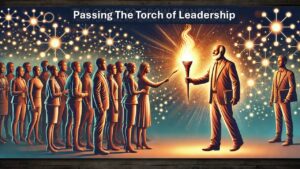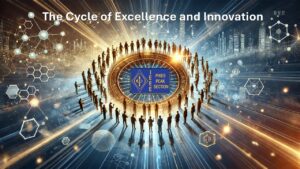Why Fit In When You Were Born to Stand Out: The IEEE Leadership Journey from GROW to GLOW to GROW
Introduction
In engineering, as in life, progress is never linear—it is an ongoing cycle of learning, innovation, and leadership. Within IEEE, this cycle is captured in the seamless transition from GROW to GLOW and then GLOW to GROW, a leadership model that empowers engineers to move beyond technical mastery and become catalysts for future generations.

At its core, Dr. John Santiago’s words: “Why fit in when you were born to stand out?” is based on his 50-plus year technical leadership journey as an engineer in the Air Force, university educator and bucket-list entrepreneur since graduating from high school way back in 1973.
Too often, despite being in the military, professionals fall into the trap of conformity (vs creativity), following established norms rather than pushing boundaries. But true leadership and innovation require something different—a willingness to embrace one’s unique potential, step forward, and inspire others to do the same. That is, a good leader and mentor is a good teacher. This is the essence of the GROW-GLOW cycle, and it is the foundation upon which IEEE continues to thrive. In contrast and in academics for example, some professors are afraid to take risks in innovative teaching since it may jeopardize their possibilities of tenure and others are comfortable with their old ways and rather do research than teach. In other words, as an academic for 20 years, the author’s observation understands that this may have to do with institutional inertia, personal ambition, and the challenge of balancing teaching, research, and career security. I assume technical leadership development is not discussed much in the classroom or in other academic setting for engineers.
Consequently, and thankfully, the IEEE has continued to serve as a leadership laboratory and teaching platform to serve our professional members as well as future students and faculty but will require increasing industry engagement to align student skills with industry market needs. In other words, engineering students graduating from universities are employable and industry-ready. If you are in military academies, leadership is embedded in their rigorous academic curriculum. From this author’s perspective, when teaching at the United States Air Force Academy, he observed that it is an engineering school with a leadership program. This can be explained since General George Washington laid the foundation for military academies given his technical background as a surveyor and agricultural engineer (farmer) who also developed an early prototype for submarines. We also note that Engineering Week is also celebrated during the week of his birthday, February 22, 1732.
From GROW to GLOW: Developing the Skills to Stand Out
The first stage of leadership development within IEEE begins with GROW—the phase where young professionals and early-career engineers cultivate the skills, mindset, and resilience needed to rise above mediocrity. As an example, the Kern Entrepreneurial Engineering Network (or KEEN) is a movement to help revolutionize the teaching of engineering as a result of the dropout rate of budding engineers. Their framework involves having an entrepreneurial (or leadership) mindset to work in tandem with the powerful technical skillset. Having an entrepreneurial mindset does not necessarily you will start a business, but you have developed a system or ‘big picture’ perspective in finding impactful societal benefits and economically viable solutions for your employer. The author notes that having an entrepreneurial mindset is a multiplicative factor to your important technical skillset.
To Give is to move beyond passivity and actively engage with the engineering community. Many young professionals assume that their role is to learn from others until they gain enough experience to contribute. But growth does not come from waiting—it comes from participating, collaborating, and seeking ways to add value, whether through technical discussions, IEEE initiatives, or mentorship.
Resilience is essential in a field where failure is inevitable. The best engineers and leaders are those who understand that obstacles are not roadblocks but opportunities for learning. IEEE provides an environment where young professionals can fail safely, surrounded by mentors and peers who help them refine their problem-solving skills and build the perseverance needed to thrive.
Optimization is the key to standing out. The best engineers are not just hard workers; they are smart workers—individuals who refine their skills, improve efficiencies, and challenge the status quo. Through IEEE conferences, technical workshops, and global collaboration, professionals learn how to optimize their contributions and maximize their impact.
Wisdom is the final and most crucial element of GROW. While knowledge can be learned from books, wisdom comes from experience, mentorship, and critical thinking. IEEE provides access to some of the brightest minds in engineering, offering young professionals a unique opportunity to absorb real-world insights and develop the strategic thinking that sets great leaders apart.
With these four pillars, Give, Resilience, Optimization, and Wisdom (GROW) in place, an individual GROWS into a leader—not by fitting in, but by actively shaping their future and the future of engineering. And as they evolve, their expertise and leadership begin to shine outward, marking their transition into the next phase: GLOW.
The GLOW Phase: The Visibility of Leadership and Influence
Once an individual reaches a level of professional mastery, their work, leadership, and influence become visible to others. They GLOW not because they seek attention with IEEE awards, but because their contributions naturally make an impact.
Growth continues, but it is no longer just personal—it expands to teams, projects, and the IEEE community (namely, team and organizational leadership from earlier news articles from the author). These individuals are no longer just learning; they are leading technical initiatives, driving innovation, and mentoring others.
Learning becomes even more critical. True experts recognize that the moment they stop learning, they begin to fall behind. The best IEEE leaders stay ahead of emerging technologies, contribute to global discussions, and ensure they remain at the forefront of their fields.
Opportunity Outreach defines those who GLOW. Leadership is not about personal success; it is about creating opportunities for others. This is where seasoned professionals take on mentorship roles, guide young engineers, and ensure that knowledge is passed down in meaningful ways.
Work takes on a new meaning. At this level, it is no longer about executing tasks—it is about making strategic decisions, shaping industries, and ensuring that the future of technology is built on ethical, sustainable, and innovative principles.
By this stage, an IEEE member no longer fits in—they stand out as a beacon of leadership, knowledge, and vision. But the journey does not end here. True leadership is not about glowing alone—it is about reigniting the growth of others.
The GLOW-to-GROW Transition: From Personal Achievement to Collective Impact
At the peak of one’s career, the focus shifts from individual success to a higher purpose: ensuring that future generations can thrive. This is where IEEE Life Members and seasoned professionals must transition from GLOW back to GROW—but this time, with a new focus.
The IEEE Pikes Peak Section (PPS) has a long-term strategic plan, that aligns with IEEE Region 5 priorities as well as the PPS strategic goals.
GIVING becomes a responsibility rather than an option. At this stage, an IEEE Life Member’s greatest impact is not in their past achievements, but in the engineers, they mentor, the ideas they support, and the knowledge they transfer.
RESILIENCE is no longer just about personal endurance—it is about ensuring that young engineers have the strength to navigate an ever-changing technological landscape. With AI, blockchain, quantum computing, and other disruptive technologies emerging at rapid speed, Life Members must help younger generations understand that change is not a threat, but an opportunity.
OPTIMIZATION now applies to IEEE itself. Life Members possess a level of experience that allows them to see where the organization can improve, where mentorship can be enhanced, and where policies can be refined. Their contributions help streamline IEEE’s structure, ensuring that it continues to be the premier global hub for engineering innovation and collaboration.
WISDOM, at this stage, is about legacy. The most profound contributions a leader can make are not patents, awards, or accolades—it is the impact they leave on the next generation of leaders. Life Members are the custodians of IEEE’s legacy, ensuring that their knowledge, ethics, and insights are not just remembered but actively shape the future.
From a mentorship perspective, the IEEE Pikes Peak Section has a mini website Life Member Affinity Group (LMAG) webpage serving as examples of possible active career paths for IEEE students, members and young professionals (YP). In addition, the IEEE PPS has a YP mini website serving as a leadership tool to augment existing IEEE leadership platforms.
This transition from GLOW back to GROW completes the cycle. It ensures that IEEE remains strong, that technological progress never stagnates, and that leadership is not an exclusive privilege but a shared responsibility.
The IEEE Cycle of Excellence: A Call to Action
To IEEE’s young professionals: You were not meant to fit in—you were meant to stand out. Do not wait for leadership opportunities to be handed to you. Engage, challenge yourself, optimize your skills, and seek wisdom from those who have come before you. The future of engineering belongs to those who embrace their unique abilities and take bold steps forward.
To IEEE’s seasoned professionals: Your glow is powerful, but its true brilliance comes from illuminating the paths of others. The engineers who once mentored you shaped your career—now, it is your turn to do the same. Ensure that your legacy is not just in the technology you built, but in the leaders you help create.
To IEEE Life Members: The impact of your career is not measured by your past—it is measured by what you do now to shape the future. Your wisdom is a beacon, and your role in IEEE is far from over. By guiding, mentoring, and optimizing the next generation, you ensure that engineering excellence continues for decades to come.
IEEE is not just an organization; it is a living, evolving ecosystem of knowledge, mentorship, and leadership. The GROW-to-GLOW-to-GROW cycle ensures that we do not just create great engineers—we create great leaders.
Will you fit in, or will you embrace the journey and stand out? The future of IEEE depends on those who choose to lead.
RELEVANT AND RELATED INFORMATION
- A Fibonacci and Golden-Ratio Mentorship Challenge: STEAM-TEAMS-notes | IEEE Pikes Peak Section
- What If One Mentor Changed Everything? A Thought Experiment for IEEE – IEEE Region 5
- Thought Experiment: Building Tomorrow’s Leaders with PyramidX-OS and IEEE STEAM TEAMS – IEEE Region 5
- A Leader Builds Other Leaders: A Leader’s Reflection for Engineering Students and Young Professionals – IEEE Region 5
- Make Greatness Attainable for All: Engineering Leadership That Transforms the Future – IEEE Region 5
- What If Leadership Could Be KEEN-ly Engineered? – IEEE Region 5





